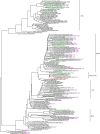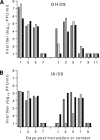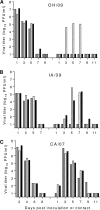Antigenically Diverse Swine Origin H1N1 Variant Influenza Viruses Exhibit Differential Ferret Pathogenesis and Transmission Phenotypes
- PMID: 29540597
- PMCID: PMC5952129
- DOI: 10.1128/JVI.00095-18
Antigenically Diverse Swine Origin H1N1 Variant Influenza Viruses Exhibit Differential Ferret Pathogenesis and Transmission Phenotypes
Abstract
Influenza A(H1) viruses circulating in swine represent an emerging virus threat, as zoonotic infections occur sporadically following exposure to swine. A fatal infection caused by an H1N1 variant (H1N1v) virus was detected in a patient with reported exposure to swine and who presented with pneumonia, respiratory failure, and cardiac arrest. To understand the genetic and phenotypic characteristics of the virus, genome sequence analysis, antigenic characterization, and ferret pathogenesis and transmissibility experiments were performed. Antigenic analysis of the virus isolated from the fatal case, A/Ohio/09/2015, demonstrated significant antigenic drift away from the classical swine H1N1 variant viruses and H1N1 pandemic 2009 viruses. A substitution in the H1 hemagglutinin (G155E) was identified that likely impacted antigenicity, and reverse genetics was employed to understand the molecular mechanism of antibody escape. Reversion of the substitution to 155G, in a reverse genetics A/Ohio/09/2015 virus, showed that this residue was central to the loss of hemagglutination inhibition by ferret antisera raised against a prototypical H1N1 pandemic 2009 virus (A/California/07/2009), as well as gamma lineage classical swine H1N1 viruses, demonstrating the importance of this residue for antibody recognition of this H1 lineage. When analyzed in the ferret model, A/Ohio/09/2015 and another H1N1v virus, A/Iowa/39/2015, as well as A/California/07/2009, replicated efficiently in the respiratory tract of ferrets. The two H1N1v viruses transmitted efficiently among cohoused ferrets, but respiratory droplet transmission studies showed that A/California/07/2009 transmitted through the air more efficiently. Preexisting immunity to A/California/07/2009 did not fully protect ferrets from challenge with A/Ohio/09/2015.IMPORTANCE Human infections with classical swine influenza A(H1N1) viruses that circulate in pigs continue to occur in the United States following exposure to swine. To understand the genetic and virologic characteristics of a virus (A/Ohio/09/2015) associated with a fatal infection and a virus associated with a nonfatal infection (A/Iowa/39/2015), we performed genome sequence analysis, antigenic testing, and pathogenicity and transmission studies in a ferret model. Reverse genetics was employed to identify a single antigenic site substitution (HA G155E) responsible for antigenic variation of A/Ohio/09/2015 compared to related classical swine influenza A(H1N1) viruses. Ferrets with preexisting immunity to the pandemic A(H1N1) virus were challenged with A/Ohio/09/2015, demonstrating decreased protection. These data illustrate the potential for currently circulating swine influenza viruses to infect and cause illness in humans with preexisting immunity to H1N1 pandemic 2009 viruses and a need for ongoing risk assessment and development of candidate vaccine viruses for improved pandemic preparedness.
Keywords: antigenic variation; reverse genetic analysis; swine influenza virus; transmissibility; viral pathogenesis.
This is a work of the U.S. Government and is not subject to copyright protection in the United States. Foreign copyrights may apply.
Figures






Similar articles
-
Comparative In Vitro and In Vivo Analysis of H1N1 and H1N2 Variant Influenza Viruses Isolated from Humans between 2011 and 2016.J Virol. 2018 Oct 29;92(22):e01444-18. doi: 10.1128/JVI.01444-18. Print 2018 Nov 15. J Virol. 2018. PMID: 30158292 Free PMC article.
-
Zoonotic infection with swine A/H1avN1 influenza virus in a child, Germany, June 2020.Euro Surveill. 2020 Oct;25(42):2001638. doi: 10.2807/1560-7917.ES.2020.25.42.2001638. Euro Surveill. 2020. PMID: 33094718 Free PMC article.
-
Pathogenesis and Transmission of Genetically Diverse Swine-Origin H3N2 Variant Influenza A Viruses from Multiple Lineages Isolated in the United States, 2011-2016.J Virol. 2018 Jul 31;92(16):e00665-18. doi: 10.1128/JVI.00665-18. Print 2018 Aug 15. J Virol. 2018. PMID: 29848587 Free PMC article.
-
[Swine influenza virus: evolution mechanism and epidemic characterization--a review].Wei Sheng Wu Xue Bao. 2009 Sep;49(9):1138-45. Wei Sheng Wu Xue Bao. 2009. PMID: 20030049 Review. Chinese.
-
Hemagglutinin Stability and Its Impact on Influenza A Virus Infectivity, Pathogenicity, and Transmissibility in Avians, Mice, Swine, Seals, Ferrets, and Humans.Viruses. 2021 Apr 24;13(5):746. doi: 10.3390/v13050746. Viruses. 2021. PMID: 33923198 Free PMC article. Review.
Cited by
-
Utility of Human In Vitro Data in Risk Assessments of Influenza A Virus Using the Ferret Model.J Virol. 2023 Jan 31;97(1):e0153622. doi: 10.1128/jvi.01536-22. Epub 2023 Jan 5. J Virol. 2023. PMID: 36602361 Free PMC article.
-
Ferreting Out Influenza Virus Pathogenicity and Transmissibility: Past and Future Risk Assessments in the Ferret Model.Cold Spring Harb Perspect Med. 2020 Jul 1;10(7):a038323. doi: 10.1101/cshperspect.a038323. Cold Spring Harb Perspect Med. 2020. PMID: 31871233 Free PMC article. Review.
-
Genetic and antigenic evolution of H1 swine influenza A viruses isolated in Belgium and the Netherlands from 2014 through 2019.Sci Rep. 2021 May 28;11(1):11276. doi: 10.1038/s41598-021-90512-z. Sci Rep. 2021. PMID: 34050216 Free PMC article.
-
Importance of 1918 virus reconstruction to current assessments of pandemic risk.Virology. 2018 Nov;524:45-55. doi: 10.1016/j.virol.2018.08.009. Epub 2018 Aug 22. Virology. 2018. PMID: 30142572 Free PMC article. Review.
-
Eurasian Avian-like M1 Plays More Important Role than M2 in Pathogenicity of 2009 Pandemic H1N1 Influenza Virus in Mice.Viruses. 2021 Nov 23;13(12):2335. doi: 10.3390/v13122335. Viruses. 2021. PMID: 34960604 Free PMC article.
References
-
- Yoon SW, Webby RJ, Webster RG. 2014. Evolution and ecology of influenza A viruses. Curr Top Microbiol Immunol 385:359–375. - PubMed
Publication types
MeSH terms
Substances
LinkOut - more resources
Full Text Sources
Other Literature Sources

